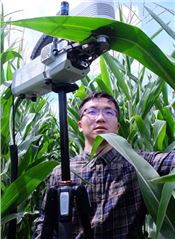How Much Spring Nitrogen To Apply? Pre-Planting Weather May Provide A Clue

Ziyi Li analyzing leaf tissue in the field.
URBANA, ILLINOIS
With the rising cost of nitrogen fertilizer and its impacts on air and water quality, University of Illinois researchers want to help farmers make more informed fertilizer rate decisions. Their latest modeling effort aims to do that by examining the role of pre-growing season weather on soil nitrogen dynamics and end-of-season corn yield.
“When farmers plant corn in spring, they already know what happened during the pre-growing season, from the previous fall to the spring.
Unlike the upcoming growing season, which we can’t reliably forecast, we can use pre-growing season information to guide farmers to adjust their fertilizer application,” says Ziyi Li, doctoral researcher in the Department of Natural Resources and Environmental Sciences (NRES) at Illinois and lead author on the new study published in Field Crops Research.
Li’s model found wetter pre-growing seasons reduced soil nitrogen through leaching. With no added fertilizer in spring, a pre-season uptick in precipitation led to yield reductions between 5 and 14 percent. But with spring fertilizer applied at about 150 lb nitrogen per acre, the 2018 average rate in Illinois, heavy pre-season precipitation still dropped yield by 1-3 percent.
“In our analysis, we found applying more fertilizer can mitigate and even eliminate the yield loss induced by excess pre-growing-season precipitation. Based on our model, if an Illinois farmer applies 150 lb of nitrogen per acre, the 1-3 percent yield loss can be prevented by adding about 16 lb more nitrogen,” Li says.
In colder-than-normal pre-growing seasons, soil inorganic nitrogen – and end-of-season yield – declined due to reduced soil microbial activity and enhanced leaching. But in this case, adding extra fertilizer in spring may not do much.
“The effects of cold pre-growing season temperatures on yield cannot be eliminated by adding additional fertilizer,” Li says. “That’s because the temperature not only affects the nitrogen content in soil, but also seems to limit early growth in ways that affect yield potential, even if weather returns to normal later.” ∆